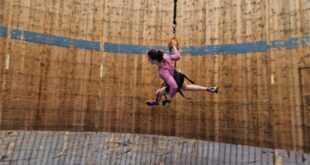The technology is in its final pilot year

Polar bears may inhabit a vastly different habitat than bears in Alberta, but the species have at least one thing in common — both are interacting with humans at an increasing rate.
Communities in Calgary and Banff have had several run-ins with black and grizzly bears this fall, as have hikers and backcountry campers in the province.
Over a thousand kilometres away, residents in Churchill, Man., have faced similar experiences with polar bears. The town is on track to set a new record for polar bear sightings this year.
While experts warn there isn't a one-size-fits-all solution to stopping unwanted encounters, one scientist believes a new radar technology could become the latest tool to help humans and bears live safely alongside each other.
For the past four years, Geoff York, senior director for science and policy at the conservation organization Polar Bears International, has been developing an AI early warning radar system that can detect polar bears remotely and send alerts to notify people of their presence.
After a latest round of fixes, the technology is in what York believes will be its final year of piloting before it becomes available to partners in other parts of the country.
"This will be a great potential tool to augment other things being done," said York.
"We still fully think the best [bear] deterrent is the one that you carry in your head … not getting into trouble in the first place as much as you can. That being said, across the bear world we're always looking at, are there new tools, new technologies we can bring?"
York said the radar system, dubbed "Bear-dar" by the organization, is based on technology developed for military use, a factor that made training the AI to recognize polar bears a time-consuming task.
"The initial AI system clearly wasn't built for wildlife, let alone bears," said York.
"Radars were designed to pick up hard targets, vehicles, airplanes, and to pick up people. Polar bears are uniquely adapted to evade radar because they're furry. And so all that soft fur makes them a very unusual radar target."
A polar bear's shape changes drastically when it turns to face radar, presenting another challenge to the team training the AI, said York. Because of the radar's sensitivity, it also had to learn how to distinguish between bears and other wildlife.
York said that once the radar system has been fine-tuned, it will be used to detect bears in places where they may come into contact with humans.
"If you're a professional conservation officer, you could put [the radar] in an area that you know is a hot spot for activity, or in an area where you have trouble with visibility, and have this basically kind of a remote 'officer,' if you will, who's able to be there 24/7 and provide you with immediate alerts as to wildlife activity near town."
Remote radar towers could also be fitted with strobe lights or loudspeakers that could be automatically triggered by a bear's presence, and used to deter it.

York said the technology could easily translate to an Alberta context.
"I could see something like this being useful where you have a bear that has gotten into some form of habituation and you're having a difficult time identifying the bear or keeping it out of a certain area."
Throughout the course of its pilot-period, the technology has been tested both in the town of Churchill and at Wapusk National Park at Cape Churchill, both of which are vast and relatively open areas.
York said that if the radar was used in a Rocky Mountain landscape, trees would limit the system's range, but it would still be effective in monitoring a geographically defined area, such as a campsite.
A 'combined package'
York said the "Bear-dar" early warning system is part of a larger program run by Polar Bears International on human-bear coexistence, which incorporates education and training for those living in polar-bear country, including residents of Churchill in Manitoba and Cree communities in northern Ontario.
The need for the initiative was sparked by changes in polar bear behaviour, said York.
"Around the Arctic, polar bears are spending more time on shore because their sea ice habitat is simply melting and pulling further away from land areas and areas of more shallow coastal water … and that's just putting them in a higher probability of getting into contact with people."
In designing the program, York said, Polar Bears International collaborated with several bear experts from Alberta to share experiences.
"We're lucky in the sense that those of you who live in the brown and black bear world are well ahead of us in many respects. Well ahead on what can communities do themselves to be safe, things from bear-proof bins and managing attractants around households and businesses."
Managing food attractants within human settlements was one priority for the coexistence program, although York said this work has to be culturally specific. There are no fruit trees in the Arctic drawing polar bears into communities, but there are other tempting food sources.
"We have a lot of people in the north who live more traditional lifestyles, and so they're smoking and hanging meats to dry naturally outside and storing natural foods outdoors."
"So we're trying to figure out ways to allow those practices to continue, for people to be able to store food and have that highly nutritious local food, but in a way that's protected from bears."
York said there are other behavioural differences between polar bears and their Alberta relatives that have to be taken into account. While the majority of grizzly and black bear attacks have happened in more remote locations, polar bear attacks, while rare, tend to occur within communities. And unlike grizzlies and black bears, polar bears don't seem to be deterred by groups of people travelling together.

Gordon Stenhouse is one of the bear experts who has collaborated with Polar Bears International on its coexistence program. He's a grizzly bear biologist, research scientist and consultant based in Hinton, Alta.
"We're working on training people on how to use the deterrent systems that we now have in place [in Alberta] to make sure that they're used safely so that people understand what they can and can't do," said Stenhouse.
He said he could see the AI radar system being a useful tool in some circumstances in Alberta.
"There may be applications, say at a camp or a worksite where it's a defined area as opposed to people that are going into the mountains, hiking or camping or doing those kind of things."
In the context of a well site, for example, Stenhouse said the radar could be installed to trigger an alert warning if a bear was detected so that people working outside could move indoors until the situation was further evaluated.
York said that as it stands, the AI radar system he's developing is expensive — on the order of $30,000 to $80,000 to get it up and running — but that he expects the technology will become more affordable over time, as production and research become more efficient.
*****
Credit belongs to : www.cbc.ca
 MaharlikaNews | Canada Leading Online Filipino Newspaper Portal The No. 1 most engaged information website for Filipino – Canadian in Canada. MaharlikaNews.com received almost a quarter a million visitors in 2020.
MaharlikaNews | Canada Leading Online Filipino Newspaper Portal The No. 1 most engaged information website for Filipino – Canadian in Canada. MaharlikaNews.com received almost a quarter a million visitors in 2020.







